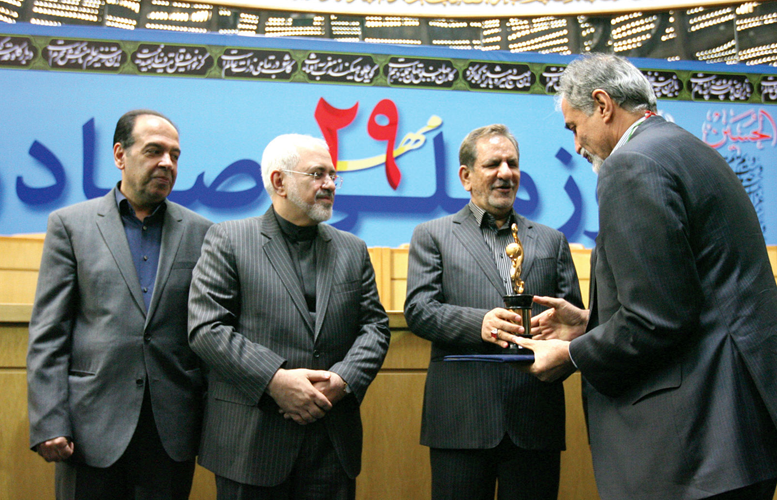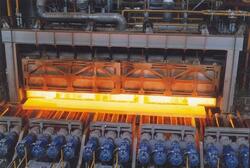
Mobarakeh Steel Company, the National Outstanding Exporter in 2015

As reported by the steel reporter during the aforesaid ceremony, Dr. Sobhani spoke with the correspondents in that conference and considered this success as the result of MSC managers and workers’ collective efforts, and pointed out upon addressing the importance of non-oil exports that, “It is not possible to manage a country with the population of 75 million without production. Replying on oil-related incomes is considered to be a kind of raw-material-selling, which is the public selling of God-given natural resources.”
“Mobarakeh Steel Company owns a suitable market by producing 50% of the Iranian steel and exporting 1.5 million tons of steel products each year. It is almost said that we are able to export any product to any desired destination with no special problem since we have a effectively entered foreign markets and well-known traders are now working with MSC through our agencies in European countries such as Italy and Germany, ranging from East to the West. This is also true with different countries in the Middle East including Iraq, Afghanistan etc so that Europe is considered to be the destination of more than 50% of Mobarake exported products,” he added.
The CEO of Mobarakeh Steel Co. pointed out the fact that steel industry is called “Mother Industry” due to its remarkable influences on the different countries’ industrial development and said, “Steel is the most important and strategic industrial product in the world such that the volume of its production and consumption indicates the countries’ improvements. The aforesaid industry plays fundamental role in national economy and welfare of the societies. Accordingly, development of steel industry is considered to be an influential factor in the development of economic, industrial, scientific, and social sectors.”
Addressing the production long term plans in MSC and the importance of production with added value, Dr. Sobhani said, “It has been planned in the Iran Prospective Document to reach 55 million tons/year of steel production by 2025. However, our present production is around 20 MTPY. Taking into account MSC role of producing 50% in Iran, our target is to reach the production of app. 20 MTPY. For this, three phases are scheduled: To increase the production capacity to around 12 million tons/year within the next two or three years; to reach the production of 16 million tons by MSC in the second phase; and to access the production of 20-22 million tons by 2025 in the third phase. Besides, products with added value is our highest priority and we are trying to direct our products towards this goal.”
He remarked the important issue that major portion of non-oil exports from Iran is related to the steel industry after petrochemical matters and pointed out that, “… of course this has been recently done in the form of iron ore.”
Chairman of Iran Steel Producers Society stated concerning the volume of steel exports by MSC that, “Mobarakeh Steel Company exported around 1,018,000 tons amounting to USD 500 million in 2013, which has been reached to 1,500,000 tons amounting to USD 750 million in2014. Despite the steel industry was in a very bad condition in 2015, we exported around 750,000 tons during the first six months.”
Focusing on the role of production in economy and the society, he reminded that, “Production leads to occupation. In case we have no production and only distribute oil income among the people, this will definitely follow with numerous corruptions. It is impossible to govern the society without hard efforts and production activities. Likewise, oil income is not stable and we have no control over its relevant market such that we watched the oil price fell down from 110 to 40 Dollars in a period.”
“We have to keep in mind that selling of raw materials means the public selling of God-given natural resources! In case we decide to put for example iron ore on sale just at the factory gate, we will only get USD 20. On the other hand, through changing the same into steel products, not only we optimize occupation in different sectors, but also the value of that iron ore will reach USD 400. Upon selling raw materials, not only we lose the above-mentioned added value, but also the occupation will increase for the purchasers and our natural resources will be spent for the other countries’ development. Consequently, the target company will export finished products with added value and a much higher price than the raw material to our country. This is the real story of selling raw material and it makes no difference in which industrial sector it occurs. Therefore, we have to stop selling raw materials.”
Concerning the steel export concerns and obstacles, the Chairman of Iran Steel Producers Society said, “Taking into account the export difficulties, this can be divided in two groups of hardware and software. The software group is mostly related to the rules, regulations, and the role and performance of the government, in which we have no special problems fortunately. However, there were some limitations during the earlier government and the export was stopped for some time, opened for a short time and let the firms do partial exports. In contrast, these obstacles have been removed in the present government and export is free for any kind and quantity. In other words, there is no limitation for the export now but the main issue is that as the local consumption increases, the government limits the export in order to manage the local market. It is expected to consider incentives for the reverse conditions too.”
Dr. Sobhani pointed out regarding the influence of export incentives that, “Export incentives are useful during the time we have 15-20% inflation per year and the government policy is to stabilize the currency. In case a producer does not have 15% more income than the previous year, he will be considered to be a losing entity. As such, it is necessary to provide industrial units with incentives if the government insists on currency rate stabilization. Of course, it is necessary to remind that providing such incentives does not mean cash injection, but this can be fulfilled through different ways as like tax exemptions or bank facilities. For example, Chinese government exempts the exporters from 50% of the sea transportation costs as an export incentive.”
Concerning post-sanctions atmosphere, CEO of Moarakeh Steel Company said that, “I am personally optimistic towards this issue and do believe that through the existing potential, we have to think about establishing those factories and industries for whom the supply of different resources like financing was limited during the past years. Steel industry is a costly sector that cannot be established through 1-3 billion bank loans. It is necessary to invest around 10,000 billion Rials, which is impracticable through the bank loans. Even if it is possible to receive such loans, repayment of 27% bank interest is not logical. Accordingly, we have to move the projects with foreign financing and loans but we hope that suitable space is opened after removing the sanctions and foreign investors come to Iran.”


Trump weighs using $2 billion in CHIPS Act funding for critical minerals

Codelco cuts 2025 copper forecast after El Teniente mine collapse

Electra converts debt, launches $30M raise to jumpstart stalled cobalt refinery

Barrick’s Reko Diq in line for $410M ADB backing

Abcourt readies Sleeping Giant mill to pour first gold since 2014

Nevada army depot to serve as base for first US strategic minerals stockpile

SQM boosts lithium supply plans as prices flick higher

Viridis unveils 200Mt initial reserve for Brazil rare earth project

Tailings could meet much of US critical mineral demand – study

Kyrgyzstan kicks off underground gold mining at Kumtor

Kyrgyzstan kicks off underground gold mining at Kumtor

KoBold Metals granted lithium exploration rights in Congo

Freeport Indonesia to wrap up Gresik plant repairs by early September

Energy Fuels soars on Vulcan Elements partnership

Northern Dynasty sticks to proposal in battle to lift Pebble mine veto

Giustra-backed mining firm teams up with informal miners in Colombia

Critical Metals signs agreement to supply rare earth to US government-funded facility

China extends rare earth controls to imported material

Galan Lithium proceeds with $13M financing for Argentina project

Kyrgyzstan kicks off underground gold mining at Kumtor

Freeport Indonesia to wrap up Gresik plant repairs by early September

Energy Fuels soars on Vulcan Elements partnership

Northern Dynasty sticks to proposal in battle to lift Pebble mine veto

Giustra-backed mining firm teams up with informal miners in Colombia

Critical Metals signs agreement to supply rare earth to US government-funded facility

China extends rare earth controls to imported material

Galan Lithium proceeds with $13M financing for Argentina project

Silver price touches $39 as market weighs rate cut outlook


















